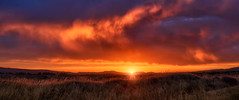 I was going to wait until June to report on fire; that’s when big thunderstorms develop in the area and produce lightning; the main ignition source for forest fires on the Island. But by mid May we have already had a lightning fire that has burned over two hundred acres; it seems like summer comes earlier than it used to.
I was going to wait until June to report on fire; that’s when big thunderstorms develop in the area and produce lightning; the main ignition source for forest fires on the Island. But by mid May we have already had a lightning fire that has burned over two hundred acres; it seems like summer comes earlier than it used to.
Fire is a broad and complex subject, but there are a few things I would like to point out: if you take a walk through our southern forest the living things you see; all plants and animals either directly or indirectly need fire. Wild fires over time have shaped the evolutionary paths of many life forms probably more than we realize. As such; fire is now necessary to maintain the health of our wild-lands. To be more specific; fire is the natural cleansing and re-fertilization agent of the forest. Fire removes dead plant material, opening up the ground to sunlight so new growth can take place. Burning also controls parasites and diseases that can harm both plants and animals. Ash created from fire is like fertilizer on the ground that ultimately benefits future generations of wildlife. This is a process that has worked itself out over time but problems do occur when man gets involved.
Fire ecologists tell us that before Europeans settled North American wild land fires were a lot more common because no one put them out. The native Americans actually started their own fires to control insects and add fertility to the soil in order to grow food. As the new Americans spread out over the continent however fire became more and more of an inconvenience: homes were at risk from burning and forestry practices that placed a dollar value on trees alone took control. The hysteria over fire reached its peak during the first half of the 1900’s when hardly any wildfires were allowed to burn and large campaigns to prevent forest fires were initiated: most of us remember Smokey the Bear; all the while burnable material (fuel) was stacking up on the ground nearly everywhere creating a huge fire hazard and harboring an increasing number of insect pests as well as restricting new growth. After the catastrophic fires that followed, people started to realize the problems with fire suppression and that the native Americans probably had it right all along. At least; frequent small fires were much better than infrequent larger ones; the way our wild-lands originally evolved. In the last couple decades, fire management has come a long way with control burning programs to reduce excessive fuel loads. On Cumberland however, two thirds of the Island lie within a designated Wilderness area that restricts control burns but requires natural fires be left alone. This becomes problematic because under certain conditions, the huge fuel loads on the Island now, could quickly create a catastrophic fire that would possibly burn too much of the Island at once and in the precess destroy much of the wildlife and old growth trees as well as some of the historical buildings. But fact remains; the Island still needs to burn or eventually it will breakdown biologically. The National Park Service which is responsible for Cumberland’s fire management is aware of these and other issues, but forced with budget constraints and politics from several different directions the agency has a daunting task in managing fire. But we have just had a two hundred acre fire with favorable results. There are roughly another twelve thousand acres that need to burn at some point in time, mostly sooner than later. It is still early in the fire season so hopefully we will get another significant burn on Cumberland in the not too distant future.














You must be logged in to post a comment.